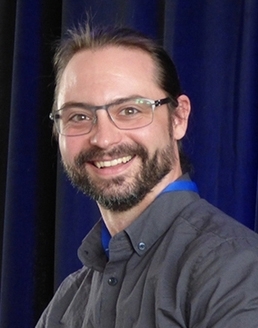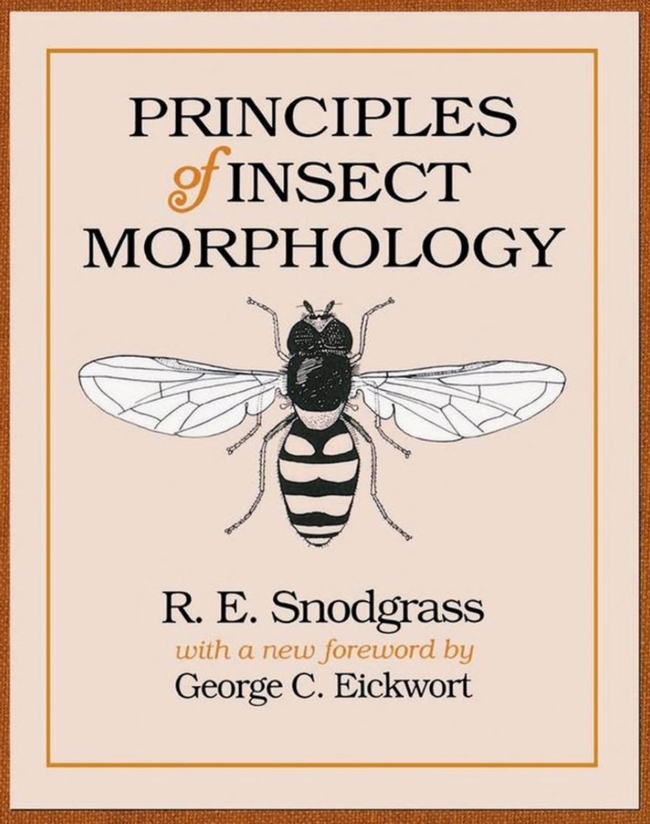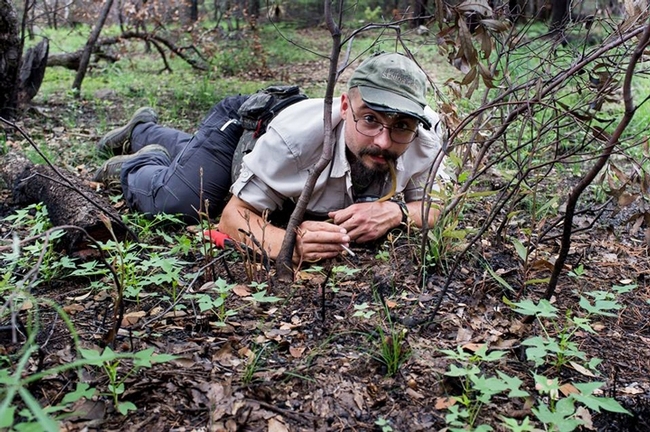
The award, which includes a certificate and a cash prize, is presented by ESA's Systematics, Evolution and Biodiversity Section.
Boudinot, who received his doctorate in entomology in June, studied with major professor Phil Ward of the UC Davis Department of Entomology andNematology. His dissertation: "Systematic and Evolutionary Morphology: Case Studies on Formicidae, Mesozoic Aculeata, and Hexapodan Genitalia.”
The Snodgrass Award recognizes outstanding research by a PhD student who has completed a research thesis or dissertation in arthropod morphology, systematics, taxonomy, or evolution. Nominees are scored on honors, awards, achievements and recognition; recommendations of professors and advisors; grantsmanship, publications, creativity and innovation of thesis or dissertation; and contribution to morphology.
Boudinot is the second UC Davis-affiliated entomologist to receive the honor in its 28-year history. Jessica Gillung of the Lynn Kimsey lab, Bohart Museum of Entomology, won the award in 2019.
Snodgrass (1875-1962), a leader in insect morphology, is known for his 76 scientific articles and six books, including Insects, Their Ways and Means of Living (1930) and the book considered to be his crowning achievement, the Principles of Insect Morphology (1935).
Boudinot has them all. “Principles of Insect Morphology and the Anatomy of the Honey Bee were the foundation of my studies,” he said. “I have both, plus his Textbook of Arthropod Morphology and Insects, Their Ways and Means of Living on my desk in the lab.”
He earlier received the prestigious Alexander von Humboldt Research Fellowship to do research on evolutionary and comparative anatomy in Jena, Germany. He will locate to Germany in early 2021 for the two-year fellowship, after completing intensive language studies.

“I am a morphologist because of Robert Evans Snodgrass,” Boudinot wrote in his application. “Although I have had pressure from my earliest undergraduate to become a molecular systematist, it was my chance encounter with Snodgrass's Principles of Insect Morphology late one night in the college library that set the course of my career. I had struggled for years at that point to understand the biodiversity of insects and to untangle the deep morass of arcane terminology, but my vision was illuminated by the conceptual clarity, linguistic simplicity, and exceptional engravings of the Principles. This work continues to hold special dominion over my thinking, as it is through the principle of mechanical function for explaining comparative anatomical observations that I have come to my present understanding of systematic and evolutionary morphology.”
Boudinot wrote that his “career objective, in brief, is to resolve the morphological evolution of insects through the synthesis traditional morphology, as represented by Snodgrass, with recent trends in digital anatomy and bioinformatics. I envision a future wherein students rely not on Borror & Delong, a holdover from Comstock's 19thCentury manual, but rather learn about insect structure, function, classification, and evolution through manipulation of three- and four-dimensional digital anatomical models, substantiated via manual curation and dissection. I want students to see for themselves what I have understood through the study of Snodgrass's work, balanced by contemporary research: The origin of the Arthropoda and morphological transformation through geological time to the resplendent, and endangered, diversity of today.
“In sum, my identity as an entomologist, and as a scientist more broadly, is due to the insights on the language and phenomenology of morphological evolution I gained from the oeuvre of Snodgrass. Without these works, I would probably still be a botanist.”

John Henry Comstock Award
Highly honored for his academics, leadership, public service activities, professional activities and publications while at UC Davis, Boudinot received the 2019 John Henry Comstock Award, the top graduate student award given by ESA's Pacific Branch. The branch encompasses 11 Western states, U.S. territories, and parts of Canada and Mexico.
In the Comstock award application, Steve Nadler, professor and chair of the Department of Entomology and Nematology, described Boudinot as “A highly respected scientist, teacher and leader with a keen intellect, unbridled enthusiasm, and an incredible penchant for public service.” Boudinot maintained a 4.00 grade point average and published 18 peer-reviewed publications on insect systematics, some landmark or groundbreaking work.
His most recent publications: one on Cretaceous Strepsiptera in Cladistics and the other on the iron maiden ants in Myrmecological News ("Two New Iron Maiden Ants from Burmese Amber (Hymenoptera:
Formicidae: †Zigrasimeciini").
Boudinot received multiple “President's Prize” awards for his research presentations at national ESA meetings. He organized the ESA symposium, “Evolutionary and Phylogenetic Morphology,” at the 2018 meeting in Vancouver, B.C. , and delivered a presentation on “Male Ants: Past, Present and Prospects” at the 2016 International Congress of Entomology meeting in Orlando, Fla.
Boudinot served on—and anchored—three of the UC Davis Linnaean Games teams that won national or international ESA championships. The Linnaean Games, now known as the Entomology Games, are a lively question-and-answer, college bowl-style competitions on entomological facts played between university-sponsored student teams.
Brendon served as president of the UC Davis Entomology Graduate Student Association from 2006 to 2019, and co-chaired the department's UC Davis Picnic Day celebration (with forensic entomologist Robert Kimsey) for three years.
Before enrolling in graduate school program at UC Davis in 2014, Brendon received his bachelor's degree in entomology in 2012 from The Evergreen State College, Olympia, Wash. Professor John T. Longino served as his mentor.
who studied with major professor Phil Ward of the UC Davis Department of Entomology and Nematology, is the second UC Davis-affiliated entomologist to receive the honor in its 28-year history. Jessica Gillung of the Lynn Kimsey lab, Bohart Museum of Entomology, won the award in 2019.
Snodgrass (1875-1962), a leader in insect morphology, is known for his 76 scientific articles and six books, including Insects, Their Ways and Means of Living (1930) and the book considered to be his crowning achievement, the Principles of Insect Morphology (1935).
Boudinot has them all. “Principles of Insect Morphology and the Anatomy of the Honey Bee were the foundation of my studies,” he said. “I have both, plus his Textbook of Arthropod Morphology and Insects, Their Ways and Means of Living on my desk in the lab.”
The Snodgrass Award, which includes a certificate and cash prize, recognizes outstanding research by a PhD student who has completed a research thesis or dissertation in arthropod morphology, systematics, taxonomy, or evolution. Nominees are scored on honors, awards, achievements and recognition; recommendations of professors and advisors; grantsmanship, publications, creativity and innovation of thesis or dissertation; and contribution to morphology.
Boudinot's dissertation: “Systematic and Evolutionary Morphology: Case Studies on Formicidae, Mesozoic Aculeata, and Hexapodan Genitalia.”
He earlier received the prestigious Alexander von Humboldt Research Fellowship to do research on evolutionary and comparative anatomy in Jena, Germany. He will locate to Germany in early 2021 for the two-year fellowship, after completing intensive language studies.
'I Am a Morphologist Because of Robert Evans Snodgrass'
“I am a morphologist because of Robert Evans Snodgrass,” Boudinot wrote in his application. “Although I have had pressure from my earliest undergraduate to become a molecular systematist, it was my chance encounter with Snodgrass's Principles of Insect Morphology late one night in the college library that set the course of my career. I had struggled for years at that point to understand the biodiversity of insects and to untangle the deep morass of arcane terminology, but my vision was illuminated by the conceptual clarity, linguistic simplicity, and exceptional engravings of the Principles. This work continues to hold special dominion over my thinking, as it is through the principle of mechanical function for explaining comparative anatomical observations that I have come to my present understanding of systematic and evolutionary morphology.”
Boudinot wrote that his “career objective, in brief, is to resolve the morphological evolution of insects through the synthesis traditional morphology, as represented by Snodgrass, with recent trends in digital anatomy and bioinformatics. I envision a future wherein students rely not on Borror & Delong, a holdover from Comstock's 19thCentury manual, but rather learn about insect structure, function, classification, and evolution through manipulation of three- and four-dimensional digital anatomical models, substantiated via manual curation and dissection. I want students to see for themselves what I have understood through the study of Snodgrass's work, balanced by contemporary research: The origin of the Arthropoda and morphological transformation through geological time to the resplendent, and endangered, diversity of today.
“In sum, my identity as an entomologist, and as a scientist more broadly, is due to the insights on the language and phenomenology of morphological evolution I gained from the oeuvre of Snodgrass. Without these works, I would probably still be a botanist.”
Boudinot's research interests include the origin and evolution of complex phenotypic systems from the perspective of phylogenetic systematics, including molecular and paleontological evidence. Specializing on morphological identity and evolutionary transformation, the skeletomuscular system of Arthropoda, with emphasis on the male genitalia of Hexapoda and systematics of the Hymenoptera, particularly the Formicidae.
John Henry Comstock Award
Highly honored for his academics, leadership, public service activities, professional activities and publications while at UC Davis, Boudinot received the 2019 John Henry Comstock Award, the top graduate student award given by ESA's Pacific Branch. The branch encompasses 11 Western states, U.S. territories, and parts of Canada and Mexico.
In the Comstock award application, Steve Nadler, professor and chair of the Department of Entomology and Nematology, described Boudinot as “A highly respected scientist, teacher and leader with a keen intellect, unbridled enthusiasm, and an incredible penchant for public service.” Boudinot maintained a 4.00 grade point average and published 18 peer-reviewed publications on insect systematics, some landmark or groundbreaking work.
His most recent publications: one on Cretaceous Strepsiptera in Cladistics and the other on the iron maiden ants in Myrmecological News ("Two New Iron Maiden Ants from Burmese Amber (Hymenoptera:
Formicidae: †Zigrasimeciini").
Boudinot received multiple “President's Prize” awards for his research presentations at national ESA meetings. He organized the ESA symposium, “Evolutionary and Phylogenetic Morphology,” at the 2018 meeting in Vancouver, B.C. , and delivered a presentation on “Male Ants: Past, Present and Prospects” at the 2016 International Congress of Entomology meeting in Orlando, Fla.
Boudinot served on—and anchored—three of the UC Davis Linnaean Games teams that won national or international ESA championships. The Linnaean Games, now known as the Entomology Games, are a lively question-and-answer, college bowl-style competitions on entomological facts played between university-sponsored student teams.
Brendon served as president of the UC Davis Entomology Graduate Student Association from 2006 to 2019, and co-chaired the department's UC Davis Picnic Day celebration (with forensic entomologist Robert Kimsey) for three years.
Before enrolling in graduate school program at UC Davis in 2014, Brendon received his bachelor's degree in entomology in 2012 from The Evergreen State College, Olympia, Wash. Professor John T. Longino served as his mentor.
Attached Images:
